Saturday, December 29, 2007
Tiger Leaping Gorge development cancelled!
Oh yeah, congratulations to our friend Sean at Walnut Grove (in the Gorge). He's been fighting this for ages!
Monday, December 17, 2007
CNN's Three Gorges piece

Even CNN has jumped on the Three Gorges catastrophe bandwagon. And I don't use 'bandwagon' in its usual negative sense here, but there are a lot of news agencies starting to report this kind of information. But, I put this one up here because it's a video report, not just the usual few lines in print. The landslides angle seems to be the recent focus of most stories.
Tuesday, December 4, 2007
Three Gorges in the news again...
 weight of water behind the dam and fluctuating water levels'. Sure, I'll buy the fluctuating water levels theory, but the weight of water has nothing to do with landslide development. It's more like the banks becoming saturated and losing cohesive strength at and below the water level. There are even reports of a landslide near Badong burying a bus and killing 30 people. Hmmm, I'd be sceptical of attributing any landslide the didn't originate at or very near the water line to the influence of the reservoir. Still, sounds very ominous and of course the potential for large wave from the landslides is huge. The Economist has a recent article outlining the impact of a landslide about 17 km upstream from the dam that happened in April. I must admit that I was in the are in June, keeping an eye out for landslides and didn't see anything in that area (it seems like it is soil cracking, not complete failure so that would be hard to spot from the riverbanks).
weight of water behind the dam and fluctuating water levels'. Sure, I'll buy the fluctuating water levels theory, but the weight of water has nothing to do with landslide development. It's more like the banks becoming saturated and losing cohesive strength at and below the water level. There are even reports of a landslide near Badong burying a bus and killing 30 people. Hmmm, I'd be sceptical of attributing any landslide the didn't originate at or very near the water line to the influence of the reservoir. Still, sounds very ominous and of course the potential for large wave from the landslides is huge. The Economist has a recent article outlining the impact of a landslide about 17 km upstream from the dam that happened in April. I must admit that I was in the are in June, keeping an eye out for landslides and didn't see anything in that area (it seems like it is soil cracking, not complete failure so that would be hard to spot from the riverbanks).There is also lots of talk, some of it from official sources, about moving another several million people from rural areas into cities, primarily within an hours drive of Chongqing, in order to
 'protect the ecology of the reservoir area'. This is supposed to be completed by the year 2020. I note that the population of Fengjie county is supposed to drop by over 40%....to bad, it's a nice place! (see photo)
'protect the ecology of the reservoir area'. This is supposed to be completed by the year 2020. I note that the population of Fengjie county is supposed to drop by over 40%....to bad, it's a nice place! (see photo)
Thursday, November 8, 2007
More Chinese dams...
While this project hasn't attracted worldwide attention (and condemnation) accorded the Three Gorges dam, it was postponed in 2005 after the builders tried to defy and order from the State Environmental Protection Agency (SEPA) to conduct a mandatory environmental impact assessment. Apparently SEPA gave the $5 billion project the green light in late 2005.

Another interesting article I came across discusses the 'dam fever' gripping southwestern China, and many of the sometimes successful efforts by NGO's to bring it under control.
On a side note, there are apparently many small 'cottage-industry' dams being constructed across China on smaller rivers for local power generation. The photo is of one under construction near Emei Mountiain in Sichuan that I stumbed across while hiking in 2006.
Friday, October 26, 2007
China to 'build' world's largest national park (?)
The park is to be an extension of Kanas Geological Park, and the extended border will incorporate 10 times the land of the original park (to 10,000 km2). Let's hope that this park won't fall victim to some of the problems with existing geological parks in China...the problems of poor public education, inadequate protection, and overdevelopment to lure in the mighty tourist Yuan. For more info on some of these problems take a look at this article from Focus on Geography. China has been putting a lot of effort recently into naming parks and having grand openings, but many (not all) of these parks don't amount to much other than tourist sites with a peripheral interest in preservation and eduation.
Thursday, October 25, 2007
Same story, different spin.
Meanwhile, China Daily are reporting that the United National Environment Program is lauding the organizers for 'greening' the games. The games are apparently a catalyst for the acceleration of environmental programs across the city. Sure, the article does mention air pollution is still an issue, but is much more confident there is still time to fix it.
Friday, October 19, 2007
Just some random China photos...
 This photo is from 2005 and is of a riverbank shipyard about 30 miles upstream from the dam. It will be completely underwater by now, as will the house.
This photo is from 2005 and is of a riverbank shipyard about 30 miles upstream from the dam. It will be completely underwater by now, as will the house.
Polished rock steps and sidewalks are very common in China, and are absolutely treacherous when it rains. There is so much polished rock being used in construction and as ornamentation that I really wonder where it all comes from. There must be entire mountains missing in sections of China!

Along the banks of the Yangtze River in Yichang, 20 miles downstream from the Three Gorges Dam. This is where many of the tourist boats tie-up overnight before going through the gorges.
Monday, October 8, 2007
17th CPC meeting heads up
http://english.cpcnews.cn/ is where you can get all of the information available. A 'media center' has just opened in Beijing to support the media, both domestic and foreign. Kind of like a hotel/convention center but just for this congress. This year the meeting seems like a bigger deal than usual because a large number of senior party members will be appointed to some very high positions. I would go into the messy politics of China when it comes to the consolidation of power on the part of the Current President, but Blogger is already blocked in China and I don't want the Chinese police knocking on my door tomorrow. If you want to get an idea of how Chinese politics works just take a good close look at the (now jailed) Ex-Mayor of Shanghai (wikipedia will help). But I digress
i figured at an event as important and encompassing as the 17th CCPC they would at the very least gloss over environmental issues. So far the only document provided is the 'Communique of the Sixth Plenum of the 16th CPC Central Committee', so it's dated, but provides the most basic, bare bones goals of the Party. Kind of. It's vague and aggrandizing, but it's something. So keep on eye on it.
on another note, this website is blocked, but I can still make updates through my gmail account, kind of weird.
and yet another note: let me know what you want me to keep on eye on. I'm planning some trips and not only do I need suggestions of where to go, but what to look out for. If you do this class again, or anything like it, i'd love to send you some pictures or whatever information i might be able to pass on.
Thursday, September 27, 2007
Potential catastrophe at Three Gorges
"We have to make concerted efforts to attain the dual goals of constructing a first-rate hydraulic project and making it into a top-level showcase for the environment," said Wang, "we will work harder to turn the Three Gorges Reservoir Area into an environmentally-friendly society."

Landslides are certainly apparent along the banks of the river, and the engineers / geologists really should have anticipated the loosely compact soil would be prone to failure. I'm not sure how any trained geoscientist could have missed this as a major, major impact. Going back to the proposed Tiger Leaping Gorge dam and reservoir...the government needs to be extremely careful there as the soil appear much more unstable, and the potential size of land failures much greater. Luckily so far none of the landslides have been large enough to cause wave-induced damage, although certainly some of the older landslides in the area would prove catastrophic should they happen today.
Burma through Chinese media
The one story contains the following quote ' As a neighbor, China is greatly concerned about the situation in Myanmar, and we hope that all parties in Myanmar show restraint and properly handle the current situation," Foreign Ministry spokeswoman Jiang Yu told a regular press conference.
Jiang called on parties concerned in Myanmar to prevent the si tuation from becoming more complicated and spreading, and not to affect the peace and stability in Myanmar and the surrounding region.
tuation from becoming more complicated and spreading, and not to affect the peace and stability in Myanmar and the surrounding region.
China expects Myanmar could commit itself to improving the living condition of people, safeguarding the rapprochement among different ethnic groups so to resume peace and stability as soon as possible, said Jiang.'
Nothing in the article gives real detail about the players in the standoff, and no mention of protester deaths is made. China daily repeats the same article.
Tuesday, August 21, 2007
Wow, China Daily allows reader comments....
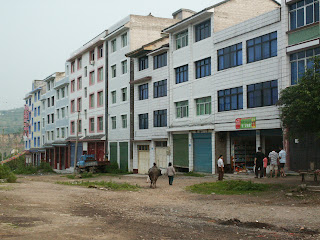 But no, comments appear to be from all ends of the spectrum, admittedly with a nationalistic hue.
But no, comments appear to be from all ends of the spectrum, admittedly with a nationalistic hue.Responses to this article (scroll down to the bottom and click on comments) on pollution by foreign multinationals quite rightly question the spin of the article. The forum hosted on the China Daily website even has a thread on multi-party governance and talk of problems facing China. Granted the discussions are fairly shallow and in fractured Engrish, but they're there nonetheless.
Tuesday, August 14, 2007
Rats, lots of Rats.
http://www.bloomberg.com/apps/news?pid=20601080&sid=aD3se8G9E9bk
interestingly enough, their are quotes from those responsible for the wall in which they say the wall isn't really not a solution, rather something to placate worried farmers. Instead, they suggested raising the number of natural predators, whose numbers have dwindled since developing the farm land.
There is more, Much more. And much stranger, but you get used to these things in China:
because the rats number in the billions and the difficulty of disposing of a billion rat carcasses, and also because there is money to be made, the rats are being shipped off to restaurants for food.
http://www.chinadaily.com.cn/china/2007-07/16/content_5435896.htm (best picture ever)
http://abcnews.go.com/WaterCooler/wireStory?id=3381084
http://in.today.reuters.com/news/newsArticle.aspx?type=entertainmentNews&storyID=2007-07-16T104424Z_01_NOOTR_RTRMDNC_0_India-284941-1.xml
"Business is good". Stories like this make me think twice about going back.
and on that note, a little personal info:
I'm going back to China as you know, not to Beijing though, which i'm a little happy about. I'll be in a town called Jiaxing, 100km SE of Shanghai at Jiaxing University. Hopefully i 'll get some good info and stories relevant to this blog and if you guys want me to look out for anything in particular or just to put my ear to the ground, just let me know.
Friday, August 10, 2007
Air pollution may affect Olympics
 This kind of reporting only starts to hint at the issues China has to face (and has had to face) in order to put on its best face for the Games. I went out to the Olympic Park in 2005 for a look around, and was astonished at the site. It's huge, and completely surrounded by fairly well-established neighborhoods. So there's no way the site was lying empty prior to its designation as the Olympic park....but one wonders what happened to the people living there. I suppose it's like all the other times 'eminent domain' is applied in China; people must move, no complaints allowed, and fairly minimal compensation. We don't hear too much of this in the news, except for that great story on the Chongqing nail house or of course about Three Gorges relocations.
This kind of reporting only starts to hint at the issues China has to face (and has had to face) in order to put on its best face for the Games. I went out to the Olympic Park in 2005 for a look around, and was astonished at the site. It's huge, and completely surrounded by fairly well-established neighborhoods. So there's no way the site was lying empty prior to its designation as the Olympic park....but one wonders what happened to the people living there. I suppose it's like all the other times 'eminent domain' is applied in China; people must move, no complaints allowed, and fairly minimal compensation. We don't hear too much of this in the news, except for that great story on the Chongqing nail house or of course about Three Gorges relocations.I also assume that the Chinese officials will do everything in their power to ensure good air quality during the games. However, this would probably require the temporary shutting down of most factories in the region and those upwind, as well as taking most cars off the street. Of course it would all be a bit of a face-saving illusion, and the factories and cars would be back polluting as soon as the athletes go home. China (and not just Beijing...many cities are worse) really needs to start dealing with air pollution on a much longer time scale than the two weeks in August 2008.
Wednesday, August 8, 2007
Yangtze River dolphins now extinct
 The World Conservation Union (IUCN) has noted the following as threats to the species: a period of hunting by humans during the Great Leap Forward, entanglement in fishing gear, the illegal practice of electric fishing, collisions with boats and ships, habitat loss, and pollution. During the Great Leap Forward, when traditional veneration of the Baiji was denounced, it was hunted for its flesh and skin, and quickly became scarce.
The World Conservation Union (IUCN) has noted the following as threats to the species: a period of hunting by humans during the Great Leap Forward, entanglement in fishing gear, the illegal practice of electric fishing, collisions with boats and ships, habitat loss, and pollution. During the Great Leap Forward, when traditional veneration of the Baiji was denounced, it was hunted for its flesh and skin, and quickly became scarce. As China developed economically, pressure on the river dolphin grew significantly. Industrial and residential waste flowed into the Yangtze. The riverbed was dredged and reinforced with concrete in many locations. Ship traffic multiplied, boats grew in size, and fishermen employed wider and more lethal nets. Noise pollution caused the nearly blind animal to collide with propellers. Stocks of the dolphin's prey declined drastically in recent decades as well, with some fish populations declining to one thousandth of their pre-industrial levels.
In the 1970s and 1980s, an estimated half of Baiji deaths were attributed to entanglement in fishing gear. By the early 2000s, electric fishing was considered "the most important and immediate direct threat to the Baiji's survival." Though outlawed, the destructive fishing technique is widely practised throughout China. The building of the Three Gorges Dam further reduced the dolphin's habitat and facilitated an increase in ship traffic. (text in italics from Wikipedia)
Officially a species cannot be termed extinct until 50 years after the last sighting, so this species is termed 'functionally extinct'. Terminology doesn't really matter here, what does is the fact that it appears to be directly linked to environmental issues, including fishing practices, water pollution, habitat losses, and the construction of large dams such as Gezhouba and the Three Gorges. A shame really.Tuesday, July 24, 2007
The Sluice
Three Gorges facing flood peak but doing well via China Daily
Saturday, July 14, 2007
Winchester on Wulingyuan National Park
I've been learning a lot about Chinese nationalism at the this NEH institute I am attending. All the presenters have agreed that Chinese nationalism is the biggest cultural force in China today. Interestingly, nationalism in the Western sense of the word is a new phenomenon there, growing out of the collapse of the Qing dynasty. Western nationalism requires you to think of your people as one nation competing among many, so that you can root for your nation in the competition. When the Middle Kingdom was simply the center of the universe, there really wasn't a need for nationalism in any recognizable sense.
Also interesting: Winchester is working on a book about Joseph Needham, the historian of Chinese science.
Sunday, July 8, 2007
Water transfer scheme
Xinhua has an article indicating that two tunnels under the Yellow River are now under construction as a part of this project. Another article indicates that the Three Gorges reservoir has just been lowered in anticipation of flooding. I find it amazing the number of water resource-related articles coming out of Xinhua. Here's another one.
Saturday, July 7, 2007
who is a bigger ethnowhore? The ethnic minority wearing in costume at the Stone Forest getting their picture taken with tourists or our group getting our picture taken with tourists?
The same goes for more than just getting pictures taken. In the two times I've been to China I have unwittingly, but sometimes purposefully, exported a piece of my culture. Whether I was showing off my sick dance movies, or teaching Chinese people about hockey, I sold a piece of my culture. Is that all it takes to be considered an "ethnowhore" (great word, by the way, Rob.) What would one have to do in order to become an ethnowhore and in the end, does it preserve diversity? At what cost?
Monday, July 2, 2007
More about rubble....
 I watched from a window across the street while people came to the site, did a few reversing manouvers, and then got some papers stamped. I just loved how informal it all was, and set amongst the lovely rubble.
I watched from a window across the street while people came to the site, did a few reversing manouvers, and then got some papers stamped. I just loved how informal it all was, and set amongst the lovely rubble.Also in Xiamen was another of China's oddities. The city on the southeast coast is directly across from Taiwan, and in fact there are two islands not far offshore of the mainland that are controlled by Taiwan. A whole industry of "Taiwan watching" has grown up along the shore, with entrepreneurs setting up powerful telescopes and charging for viewing Taiwan. You can see the Taiwanese island of Quemoy in the background. Very strange...

Friday, June 29, 2007
Rubble rubble everywhere....
 As much as I love travelling through China and find it a mesmerizing place, there is one thing that I find really troubling. It is impossible (ok, very difficult) to find any place that has not been disturbed by humans in some manner. Rob and I first talked about this in terms of soil disturbance, and I thought it would be nearly impossible to find a truly well-developed natural soil profile, except in really remote areas. This doesn't apply to all parts of China, but there is a stunning lack of natural landscape. Even places set aside as parks or preserves tend to be groomed or landscaped, as Kate pointed out about the Stone Forest.
As much as I love travelling through China and find it a mesmerizing place, there is one thing that I find really troubling. It is impossible (ok, very difficult) to find any place that has not been disturbed by humans in some manner. Rob and I first talked about this in terms of soil disturbance, and I thought it would be nearly impossible to find a truly well-developed natural soil profile, except in really remote areas. This doesn't apply to all parts of China, but there is a stunning lack of natural landscape. Even places set aside as parks or preserves tend to be groomed or landscaped, as Kate pointed out about the Stone Forest.
And it's not just the clearing or land that is disturbing. If the land isn't being farmed or is built upon, then it's generally covered in rubble. Rubble, rubble everywhere. Bricks, broken rocks, bits of scrap building material - everywhere. I went to a small village on the banks of the Yangtze a few years ago where at least they were growing watermelons amongst the rubble, but in most places it's just piled up waiting for who-knows-what.
Monday, June 25, 2007
China recycles!
 One of the things that struck me in China was the level to which the country recycles. While we may do household recycling in North America, the Chinese take it one step further. Garbage bins in major cities have two sides to them, one for garbage and one for recyclables. Mind you, with the need to drink bottled water in China they must go through a huge number of plastic bottles annually. There is apparently a refund for them too, as in many places you see people collecting them from users, or pulling them out of the recycling bins.
One of the things that struck me in China was the level to which the country recycles. While we may do household recycling in North America, the Chinese take it one step further. Garbage bins in major cities have two sides to them, one for garbage and one for recyclables. Mind you, with the need to drink bottled water in China they must go through a huge number of plastic bottles annually. There is apparently a refund for them too, as in many places you see people collecting them from users, or pulling them out of the recycling bins.I don't have a photo of the two-sided bins, but this one from Beijing is more interesting.
Friday, June 22, 2007
Another great internet resource
Thursday, June 21, 2007
Lijiang: Is it real?
 But I really wonder how much of the old part of the city is real and how much has been reconstructed. Searching the internet, I found articles (here, here and here) that discuss the damage. Many reports and tour guides indicate that the older structures in the historic part of town withstood the earthquake quite well, while more modern construction suffered more damage. But looking at these articles it is obvious that damage was widespread, old and new, and a map (Figure 8 in this article) shows a significant number of deaths in the old part of town.
But I really wonder how much of the old part of the city is real and how much has been reconstructed. Searching the internet, I found articles (here, here and here) that discuss the damage. Many reports and tour guides indicate that the older structures in the historic part of town withstood the earthquake quite well, while more modern construction suffered more damage. But looking at these articles it is obvious that damage was widespread, old and new, and a map (Figure 8 in this article) shows a significant number of deaths in the old part of town.So how much has been rebuilt into the tourist draw that it is today? I saw sections at the periphery of the "old town" that were being constructed to look old. I also noticed that the canals running through the old town had large drains in their beds, like western manhole covers. Lijiang is called the "Little Venice of the Orient", but I'll bet Venice doesn't have drains in its canals. That to me points to a rather unnatural, yet very aesthetically pleasing, canal system, but also raises the question of authenticity. Certainly still worth a visit though!
Thursday, June 14, 2007
Tiger Leaping Gorge: Another Megadam?
 Rob's post below looks at the area around the megadam that everyone seems to know about - the Three Gorges Dam. Construction there started in 1994 and will only be completed in 2009, with the final rise in water level to 175m above sea level. That's a total rise of almost 80 m in sections close to the dam. That one's a done deal, with most of the construction and relocation already complete. But what the world doesn't really know about are the plans to dam the Yangtze 1500 km further upstream, in the famous Tiger Leaping Gorge of Yunnan Province. This dam would be purely for energy production, as the site is upstream of the traditional navigable Yangtze.
Rob's post below looks at the area around the megadam that everyone seems to know about - the Three Gorges Dam. Construction there started in 1994 and will only be completed in 2009, with the final rise in water level to 175m above sea level. That's a total rise of almost 80 m in sections close to the dam. That one's a done deal, with most of the construction and relocation already complete. But what the world doesn't really know about are the plans to dam the Yangtze 1500 km further upstream, in the famous Tiger Leaping Gorge of Yunnan Province. This dam would be purely for energy production, as the site is upstream of the traditional navigable Yangtze. It's really hard to get accurate information about these dam plans. We heard several different versions from people we met, ranging from a huge single dam to a series of 8 smaller dams through the 25 km long gorge. Note that the Times Online has an article suggesting the single dam approach would yield a dam 278 m high and a reservoir almost 200 km long. An Asia Times article written also written in 2006 suggests the 8 dam plan is in the works.
It's really hard to get accurate information about these dam plans. We heard several different versions from people we met, ranging from a huge single dam to a series of 8 smaller dams through the 25 km long gorge. Note that the Times Online has an article suggesting the single dam approach would yield a dam 278 m high and a reservoir almost 200 km long. An Asia Times article written also written in 2006 suggests the 8 dam plan is in the works. I managed to find a tunnel near Walnut Grove that researchers had obviously excavated in order to look at fracturing in the marble. There are a lot of other obvious signs that geotechnical testing is underway. As I see it, one of the biggest challenges for the dam builders would be the issue of landslides. Landslide debris is found throughout the gorge, and the only road through the gorge is currently blocked by three large slides. The entire village of Walnut Grove is situated on an old landslide perhaps 2 km wide. Saturating the banks of the gorge when the water level is raised further weakens the strength of the rock, so if this many landslides are happening now, it doesn't bode well for the post-dam gorge.
I managed to find a tunnel near Walnut Grove that researchers had obviously excavated in order to look at fracturing in the marble. There are a lot of other obvious signs that geotechnical testing is underway. As I see it, one of the biggest challenges for the dam builders would be the issue of landslides. Landslide debris is found throughout the gorge, and the only road through the gorge is currently blocked by three large slides. The entire village of Walnut Grove is situated on an old landslide perhaps 2 km wide. Saturating the banks of the gorge when the water level is raised further weakens the strength of the rock, so if this many landslides are happening now, it doesn't bode well for the post-dam gorge. So why should we care about landslides in the area, especially if they plan to move most of the people out of there? Check out the Vajont disaster that killed 1,450 people in Italy when a landslide triggered a huge wave that overtopped the dam and inundated the town below. The largest waves in the world have all been triggered by landslides into open water. If they build this dam, I wouldn't think it safe to keep any people in the valley, even if your house and land are above the new water level.
So why should we care about landslides in the area, especially if they plan to move most of the people out of there? Check out the Vajont disaster that killed 1,450 people in Italy when a landslide triggered a huge wave that overtopped the dam and inundated the town below. The largest waves in the world have all been triggered by landslides into open water. If they build this dam, I wouldn't think it safe to keep any people in the valley, even if your house and land are above the new water level.Life on the Yangtze
Like the St. Lawrence, the Yangtze is not really a river, but a "seaway," with all aspects of the river ecosystem pushed out by the needs of shipping. You don't see many people fishing on the river. This visit I only saw one fishing boat, although last time, when I spend more time and covered a longer stretch of the river I saw more. Mostly what you see is this:
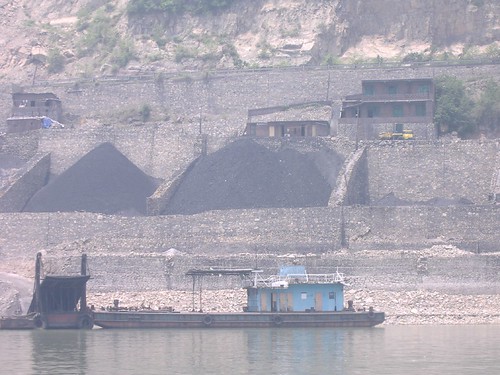
Coal, the blood of the current Chinese economy. Small hoppers of coal line the banks of the Yangtze. Dump trucks bring the coal, typically from small, independently run mines with poor safety standards. The kind of mining disaster that makes national news for weeks if it happens in West Virginia happens every day in China.
Concrete reinforced banks add a lot to the sense that the Yangtze is a highway.
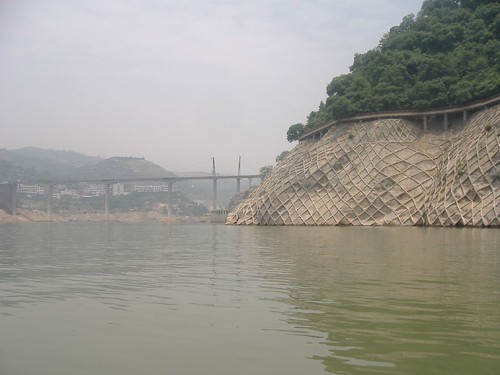
To deal with erosion after the flooding caused by the new dam, the government put nets over the steeper banks of the river and coated them with concrete. Most of this will be under water when the dam is fully operational. In case you forget how high the water will be by then, there are constant reminders
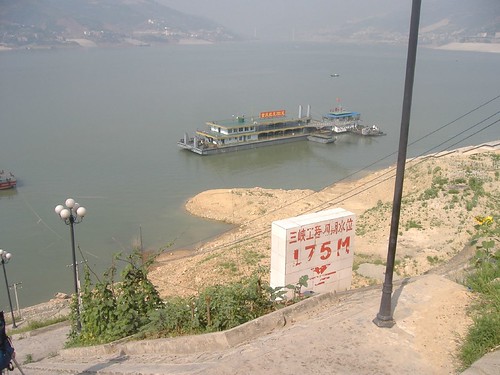
Officially, the flooding has forced the resettlement of 1.1 million people, including 13 major cities and about 25 thousand hectares of farmland. (This according to the handy yellow technical guide given to tourists by the government.) Most of these people are moved to brand new relocation cities built a little farther up the river bank. About 10% are moved to entirely new provinces. The consensus seems to be that those 10% are totally fucked.
The relocation cities are quite a sight. They all have built docks at 175 m. above sea level, but since the river isn't there yet, you see huge foundations of the docks.
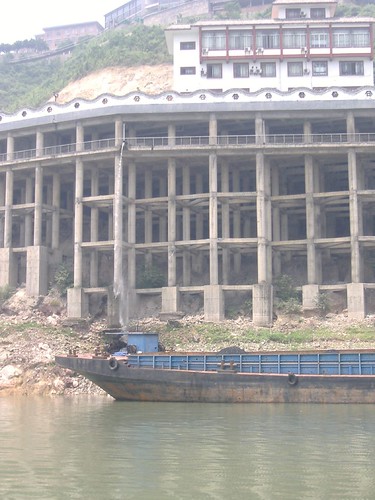
This is the dock for Fengjie. For some reason water was gushing down the side.
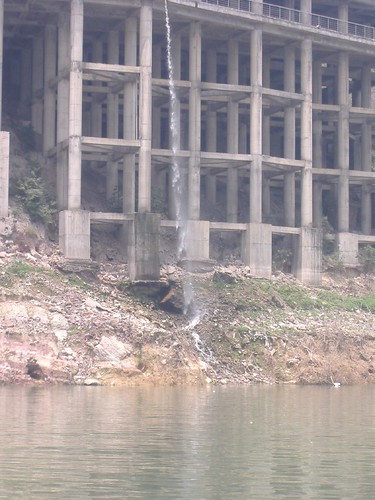
Since the river hasn't reached the permanent dock, temporary docks were built and the current level. Generally there is no way to get from the dock to the city other than climbing a buttload of stairs.
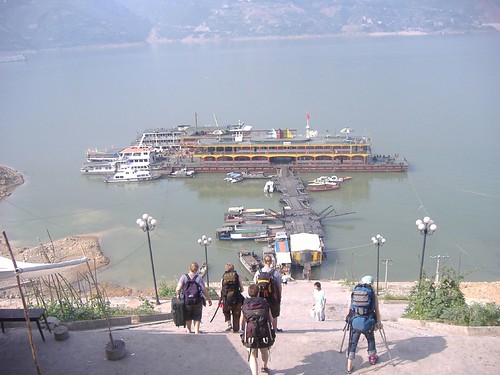
Out student Kate was traveling with a broken leg, which made the steps loathsome. Fortunately for Kate the oversupply of labor in China sometimes meant that she had alternative ways to travel.
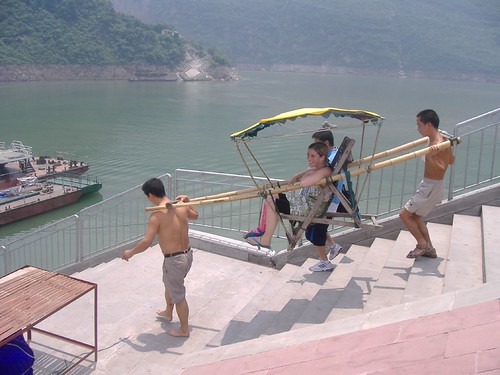
Monday, June 11, 2007
Stone Forest revisited

My second visit to the Stone Forest of Yunnan was markedly different from the first. In 2005 I visited the area while researching an article on geological parks in China. Our guide for that trip was a geologist, and we met with the park geology staff and several academics conducting research in the area. The article (in Focus on Geography: Winter 2006) described the park and its educational efforts in somewhat glowing terms. Yet, I think I really was seeing the park through the eyes of a geologist, not one of the masses of tourists.
Our group visit in May 2007 was as tourists. We gave no advance warning and there was no party of cadres ready at the gate to answer all of our questions. Hoards of tourists were milling about, all seemingly refusing to progress more than 200 m inside the park. They stayed on the paths and many were carted around in open-air buses. Typical Chinese tourism some might say, take photos where told and don't really experience the park, just tick it off your checklist to tell the folks back home. I had a feeling of depression, knowing that off the beaten path was a wonderfully strange geological site, yet none of the visitors seemed to grasp that. Nor were they interested.

Part of the mandate of World Geoparks is that they must promote geological heritage education. There certainly are informative signs scattered about the park. But, there are no guidebooks available to the general public, and the location of the museum remained a bit of a mystery (none of the guides knew of its existence). In 2005 the park officials were eager to mention a new geological museum was under construction, although we didn't see it. Apparently not many people do in 2007 either!
Once again it seems that mass tourism has trumped educational tourism. Or is it just that the culture of tourism differs in the east?